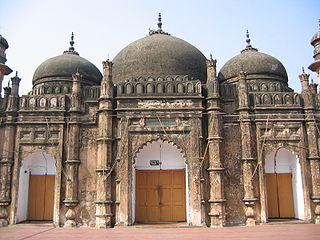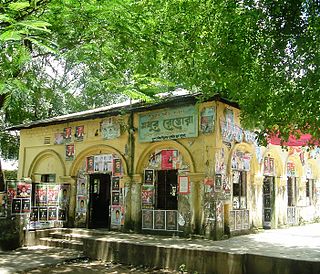
The Shaheed Minar is a national monument in Dhaka, Bangladesh, established to commemorate those killed during the Bengali Language Movement demonstrations of 1952 in then East Pakistan.

The University of Rajshahi, also known as Rajshahi University or RU, is a public research university located in Motihar, Rajshahi, Bangladesh. It is the second oldest university in Bangladesh. The university's sixty departments are organized into ten faculties.

State University of Bangladesh (SUB) is a private university in Dhanmondi, Dhaka, Bangladesh. It was established in 2002 under the Private University Act 1992.

The Institute of Business Administration of the University of Dhaka, commonly known as IBA, is a business school located in Dhaka, Bangladesh.

Dhaka College is the oldest secular educational institution of Bangladesh located in New Market, Dhaka 1205. It offers higher secondary education (HSC). It has Honours and Masters programs as well which are affiliated with the University of Dhaka.

Dhaka (Dacca) is one of the oldest inhabited mega cities of the World. The history of Dhaka begins with the existence of urbanised settlements in the area that is now Dhaka dating from the 7th century CE. The city area was ruled by the Hindu Gauda Kingdom, Buddhist and Shaivite Pala Empire before passing to the control of the Hindu Sena dynasty in the 10th century CE. After the Sena dynasty, the city was ruled by the Hindu Deva Dynasty. Dhaka was successively ruled by the Turkic and Afghan governors descending from the Delhi Sultanate, followed by the Bengal Sultanate, before the arrival of the Mughals in 1608. The city became proto-industrialised and declared capital of the Mughal Bengal and commercial (financial) capital of the Mughal India. The Dhaka natural riverine port has a recorded existence since the 16th century CE. Dhaka's strategic riverine location in Bengal made it a hub for Eurasian traders, including Armenians, the Portuguese, French, Dutch and British. The bustling old city was known as the Venice of the East. After Mughals, British ruled the region for 200 years until the independence of India in 1947. After the independence of Bangladesh in 1971, Dhaka became the capital of the new state.

Shahbagh is a major neighbourhood and a police precinct or thana in Dhaka, the capital and largest city of Bangladesh. It is also a major public transport hub. It is a junction between two contrasting sections of the city—Old Dhaka and New Dhaka—which lie, respectively, to its south and north. Developed in the 17th century during Mughal rule in Bengal, when Old Dhaka was the provincial capital and a centre of the flourishing muslin industry, it came to neglect and decay in early 19th century. In the mid-19th century, the Shahbagh area was developed as New Dhaka became a provincial centre of the British Raj, ending a century of decline brought on by the passing of Mughal rule.

Bahadur Shah Park, formerly known as Victoria Park, is a park located in Old Dhaka, Bangladesh. It has a memorial dedicated to the soldiers killed by the British in the aftermath of the Indian Mutiny of 1857. It was built in 1858 at the initiative of Nawab Khwaja Abdul Ghani, in the Sadarghat area. It was named Victoria Park until 1947. After that, it was renamed after Bahadur Shah II, the last Mughal emperor.

The Khan_Mohammad_Mridha_Mosque is a historical mosque near Lalbagh Fort in Dhaka, Bangladesh.

Katra or Katara is the name given to caravanserai inns in Bengal. The Bara Katra and Chhota Katra refers to two magnificent Mughal katras in Dhaka, Bangladesh.

Chhota Katra is one of two Katras built during Mughal's regime in Dhaka, Bangladesh. It was constructed in 1663 by Subahdar Shaista Khan. It is on Hakim Habibur Rahman lane on the bank of the Buriganga River. It was built to accommodate officials and Shaista Khan's expanding family. Chhota Katra is slightly smaller than Bara Katra, but similar in plan and about 185 metres east of it.

Government Bangla College is a public college located in the northwest part of the capital city of Dhaka in Bangladesh.The college was established in 1962 by Principal Abul Kashem to promote the use of the Bangla in higher education and to establish the language in all spheres of national life of Bengalis. It is affiliated with the University of Dhaka.

Architecture of Bangladesh is intertwined with the architecture of the Bengal region and the broader Indian subcontinent. The architecture of Bangladesh has a long history and is rooted in Bangladesh's culture, religion and history. It has evolved over centuries and assimilated influences from social, religious and exotic communities. The architecture of Bangladesh bears a remarkable impact on the lifestyle, tradition and cultural life of Bangladeshi people. Bangladesh has many architectural relics and monuments dating back thousands of years.

RAJUK Bhaban is the head office of Rajdhani Unnayan Kartripakkha (RAJUK), which is the Capital Development Authority of the Government of Bangladesh. RAJUK Bhaban is situated at RAJUK Avenue, Dilkhusha, Dhaka-1000. This is one of the most well known buildings of the Dhaka city.

The Dhanmondi Shahi Eidgah, also known as Mughal Eidgah, is located in Saat Masjid road, in Dhanmondi residential area of Dhaka, Bangladesh. The Eidgah was built in 1640 CE during the Mughal era and has been in use for Eid celebration since then.
Farashganj is a neighborhood in Dhaka, Bangladesh. The name comes from the Bengali word for French which is Forashi and ganj, meaning market-town.

The Old High Court Building in Dhaka is situated at High Court Street, opposite the picturesque Curzon Hall. It was constructed in the beginning of the 20th century in Renaissance architectural style. It served as an official residence and governmental office before coming the High Court Building after the division of India in 1947.

Madhur Canteen is a familiar name in the history of the Dhaka University as well as in the national politics of Bangladesh because of its association with various political movements which originated from the Dhaka University. The canteen's current location holds important architectural and heritage value.

The University of Dhaka is a public research university located in Dhaka, Bangladesh. It is the oldest university in Bangladesh and one of the most prestigious universities in Asia. University of Dhaka is most known for the patronisation of one of most important physics discoveries of all time, when Satyendra Nath Bose FRS provided the foundation for Bose-Einstein statistics and the theory of the Bose-Einstein condensate at Curzon Hall

St Thomas Church is an Anglican Church which is also known as the Church of Bangladesh. The church premise was in an area of lush greeneries with the famous Bahadur Shah Park at a stone's throw distance on the south. The north–south axial Nawabpur Road/Johnson Road, the most important commercial street connecting the old part of the city with the new, is on the west and separated the area from the court, Bank, DC's office and Jagannath University buildings across it. In fact the church overlooking the greens is a major focal of the city centre in the nineteenth century.























